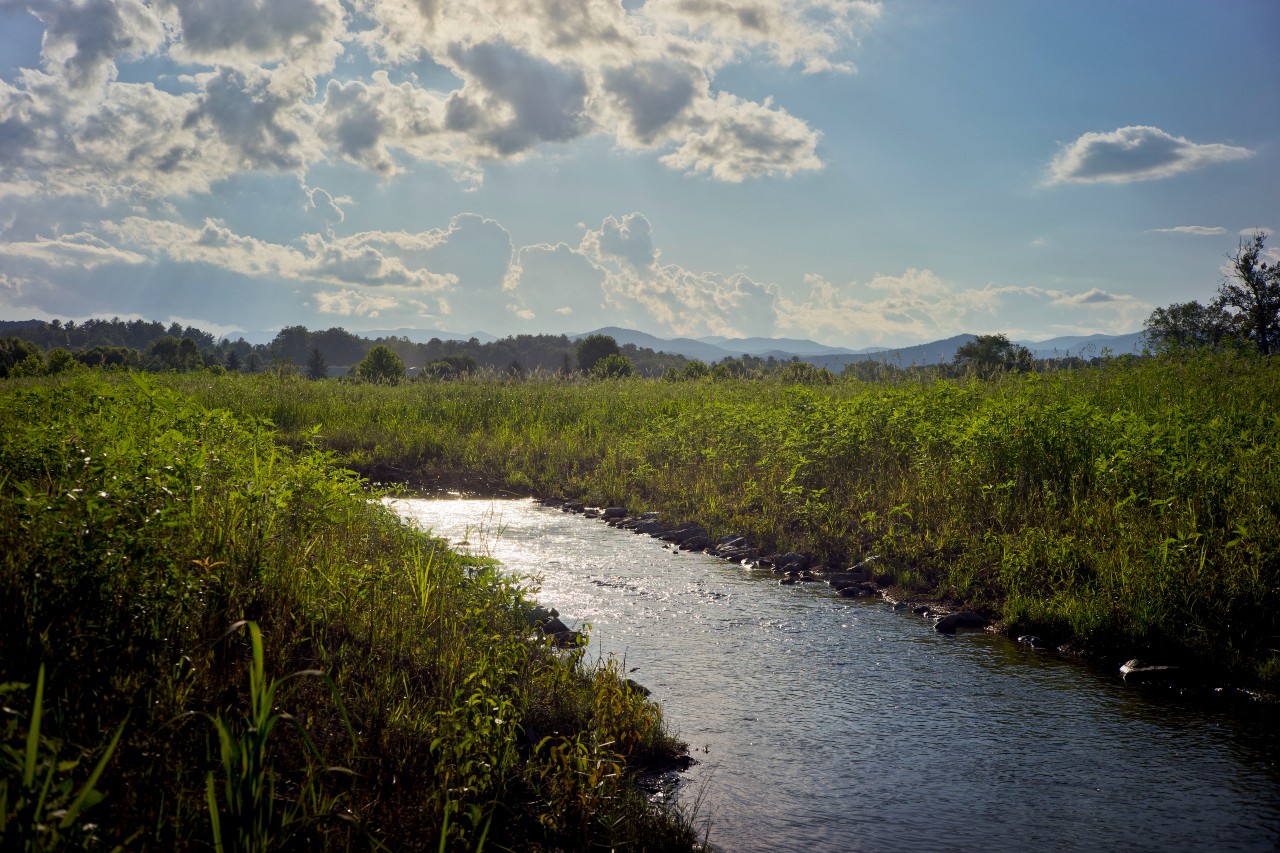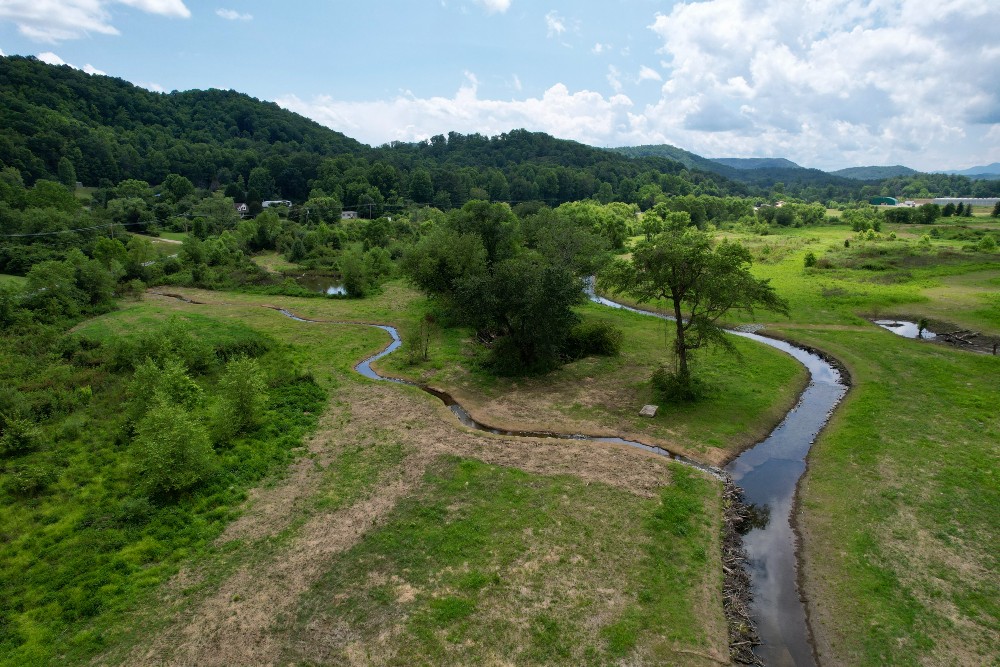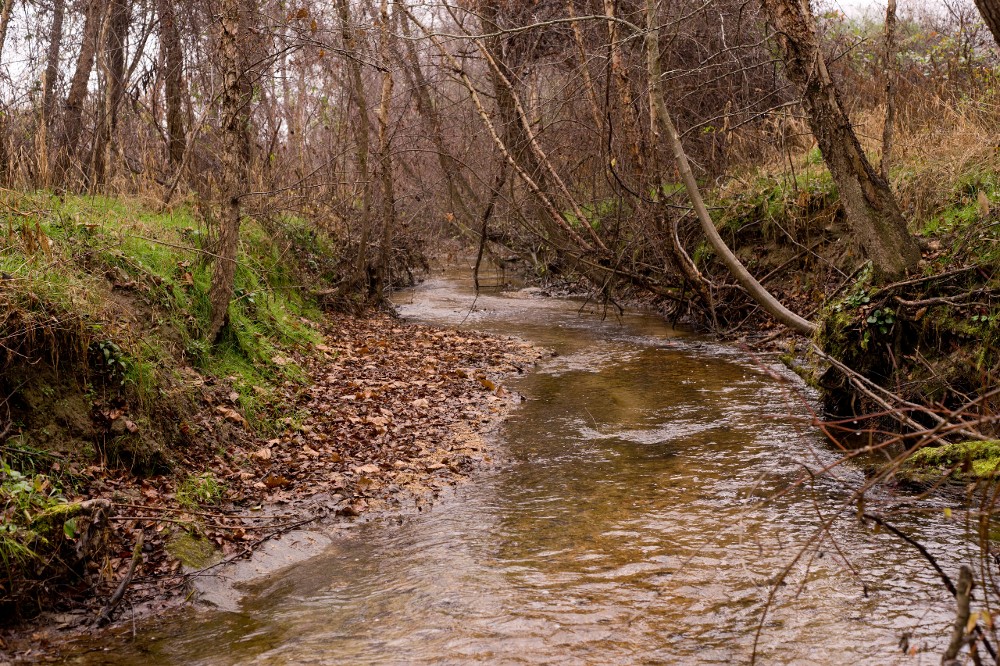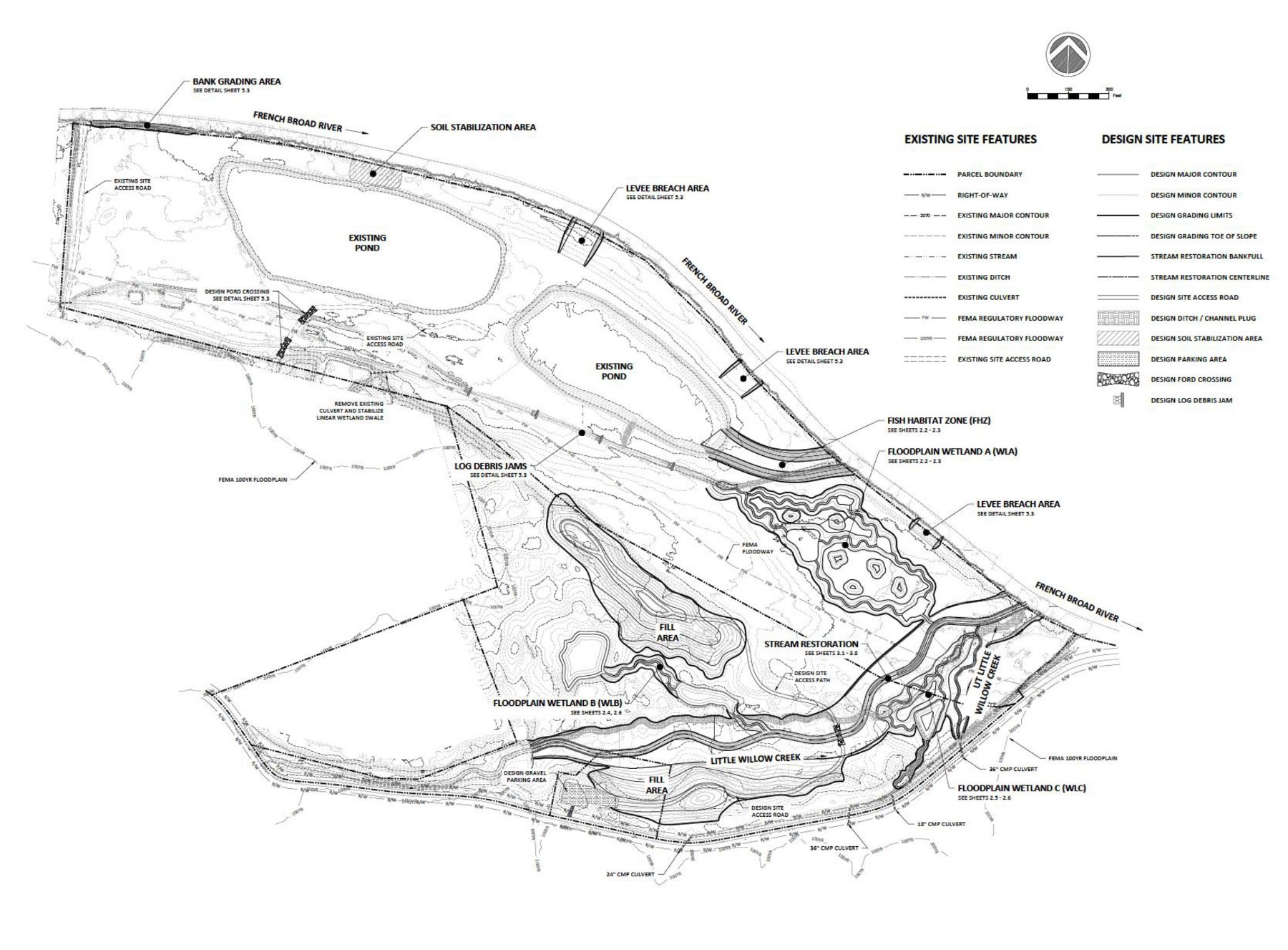Restoring A Lost Floodplain
Restoration in Etowah will offer habitat and trails by the French Broad.

“This stream is only two weeks old. It didn’t exist until two weeks ago,” said environmental engineer Greg Jennings on a tour of Pleasant Grove, a restoration project beside the French Broad River in Etowah. Where there used to be an abandoned golf course, there is a now a new stream, new wetlands, a new backwater slough, and a new channel for Little Willow Creek.
Or rather, this project is bringing back the kinds of features that existed there before, a century or more ago. This land would have been a natural floodplain where the river could spread out and low areas would fill with water. A natural floodplain like this offers prime habitat for animals like ducks, turtles, fish, salamanders, frogs, toads, dragonflies, songbirds, otters, bats, and more.
But, over time, all along the French Broad, landowners built ditches to drain the land. For example, near Pleasant Grove, someone took a stream that was flowing out of the mountains and diverted it into a roadside ditch. As part of the restoration, Jennings and his team brought that small stream back, which is why Jennings said it was only two weeks old. The restoration crew made a curving streambed for the water—now a clear, rippling stream.

At the same time as landowners were digging ditches to get water off the land, they were also building berms to keep water in the river. Walled in, the river became more like a ditch itself—draining water away instead of overflowing and filling the land with life.
Repeat that process many times and what you get is a channelized river where water has nowhere to go during storm events. Huge volumes of stormwater rush down the channel and when the river does overtop its banks, the floods are devastating. Floodwater wipes out farmers’ crops and damages roads and homes. At the same time, we’ve lost essential habitat for wildlife. And the river is more polluted, because we don’t have natural areas to filter runoff before it flows into the French Broad.
But now, at an increasing number of places along the river, that process is taking place in reverse.
Before and After


Bringing Back a Natural Floodplain
Pleasant Grove was one of three restorations led by Conserving Carolina this spring and summer, and it was also the largest at 70 acres. Conserving Carolina bought the property in 2017, as part of the failed Seven Falls development, where new homes would have been built around the golf course.
Instead, Pleasant Grove will be a place where people will be able to take a walk as trees grow back along the river and meadows blossom. During the tour that Jennings led this May, the group saw animals including red-winged blackbirds, a family of ducks, and a box turtle. As the restoration grows in, there will likely be many more creatures to see. Restoration plans identified potential benefits to eight endangered or vulnerable species, including bog turtles, monarch butterflies, and several kinds of bats.
A large-scale restoration like this involves changing the shape of the land—for example breaching levees; digging low areas for pools, sloughs, and wetlands; and reshaping steep, straightened streambanks. Rampant invasive plants were cleared out while most native trees were left in place. Bared soil was covered in mats made of coconut fiber (which biodegrades slowly) to prevent erosion. After the earth-moving stage came replanting, and native plants got a fresh start as seeds, live stakes, and saplings.
The Big Picture


What You’ll Find at Pleasant Grove
Here are some of the features that make up this extensive restoration:
Little Willow Creek: Before, it was a deep ditch. Now, this creek runs through a meandering channel with gentle banks—able to overflow and less prone to erosion.
Small Stream: This is the unnamed tributary that was previously diverted into a roadside ditch. Now it’s a clear, curving stream. In all, nearly a mile of streams were restored at Pleasant Grove.
Levee Removal: Levees, or earthen berms, were breached at three points along the French Broad, so the river is able to overflow onto its floodplain.
Riverside Forests: Trees have been planted on 29 acres beside the river. This reforestation will provide a natural buffer along the river for two-thirds of a mile.
Backwater Slough: A pond was turned into a 7-acre backwater slough with a wide channel that connects it to the river. Backwaters sloughs provide much-needed habitat for muskie and other fish.
Pond: A second existing pond was left in place, providing another 7 acres of aquatic habitat.
Plugged Ditches: Ditches that used to carry runoff from surrounding properties into the French Broad were plugged so this water will now flow through wetlands, which filter it before it reaches the river.
Wetlands: 22 acres of wetlands were created, providing habitat for a forested mountain bog.
Pollinator Meadows: Fill dirt from excavations formed higher ground, which was seeded with pollinator plants that will create 13 acres of wildflower meadows.
Future Trails: Pleasant Grove will have about two miles of trails that will be open to the public, once plants grow in and the restoration is ready for visitors.

Funding for the Pleasant Grove restoration came from the NC Land and Water Fund, NC Department of Public Safety, and National Fish and Wildlife Foundation. The project was led by Conserving Carolina, designed and overseen by Jennings Environmental, and carried out by North State Environmental with vegetation planting by Stone and Spade.
Momentum for Restoration
The project was one of three restorations that Conserving Carolina recently completed, with more restorations moving forward. In 2021, a study identified 30 landowners along the Upper French Broad River who expressed interest in restoration.
David Lee, Conserving Carolina’s Natural Resources Manager, says that momentum for restoring the French Broad River corridor has grown by leaps and bounds since the nonprofit did its first floodplain restoration at Mud Creek, in 2020.
Lee says, “Clearly, we’re not going to restore natural floodplains along the whole river. It’s not practical. We need agriculture, which is why we work to conserve farmland. We all need to eat. But there are places like Mud Creek and Pleasant Grove that can deliver huge bang for the buck. And smaller improvements at lots of properties can result in a much more vibrant river corridor.”
Mud Creek showed what was possible, Lee says. “A natural floodplain restoration had not been done in the mountains before Mud Creek. There had never been a slough created or large-scale breaking of berms. We went into that project with the goal of true ecological restoration, of restoring habitat for native plants and animals. And we’ve had discoveries—like, just recently, the spiny softshell turtle, which is rare. Those finds were beyond our expectations but not outside what we were hoping for. We’re seeing true ecological restoration, with the French Broad River connected to its floodplain.”
Article by Rose Jenkins Lane.
Thank you to Max Cooper, a professional photographer based in Asheville, NC, who donated work for this story! See his website or follow him on Instagram.
